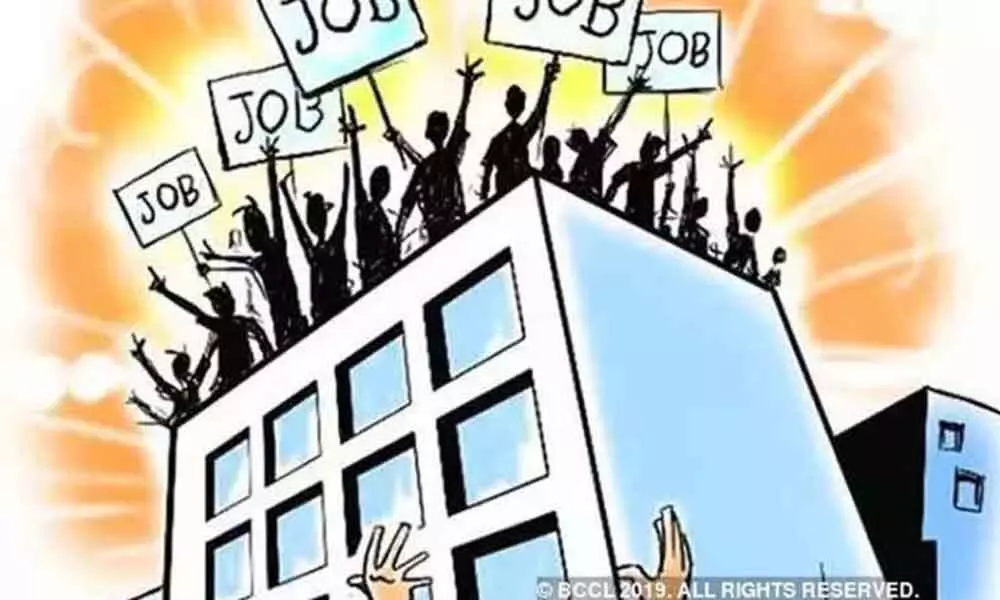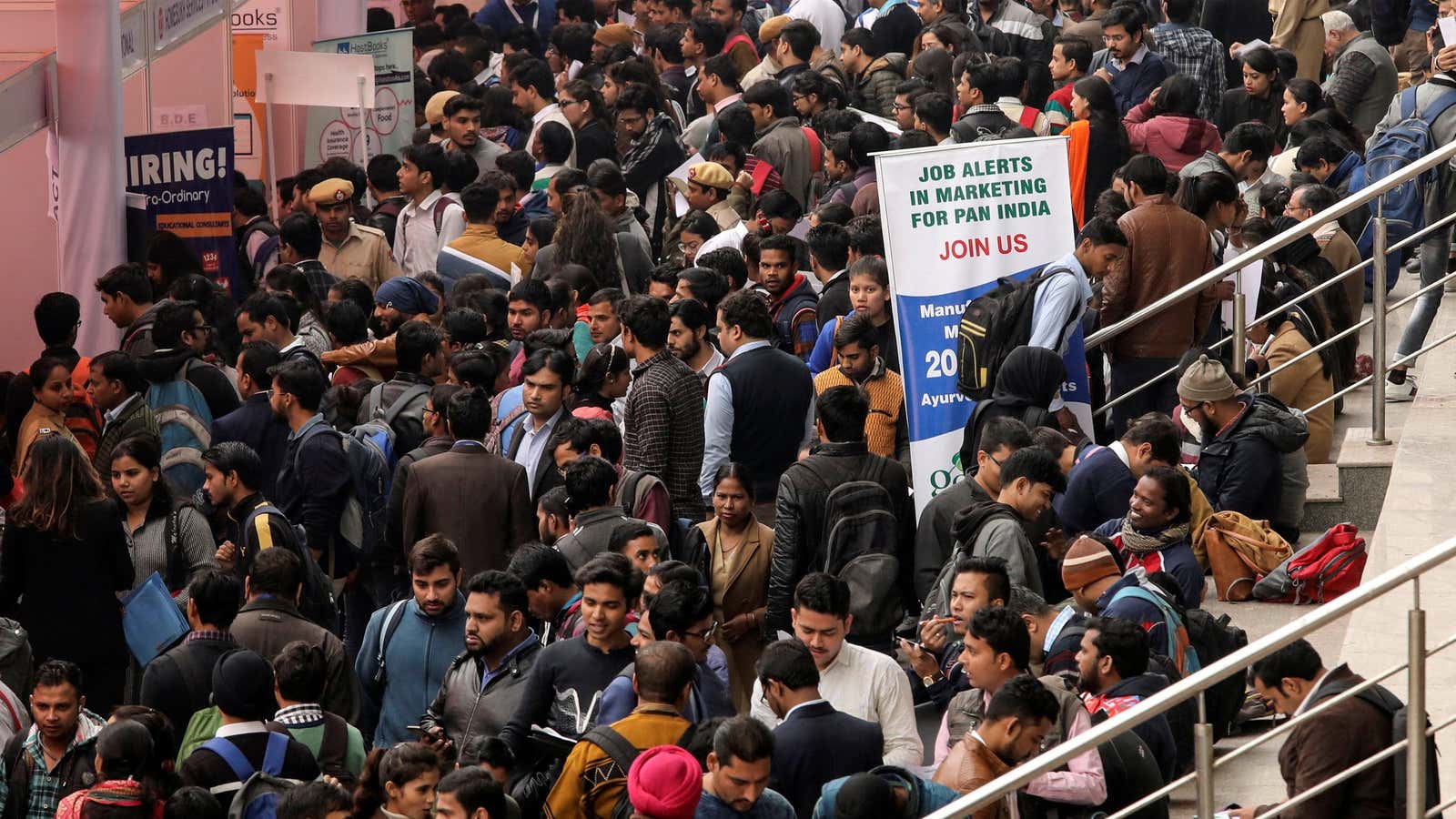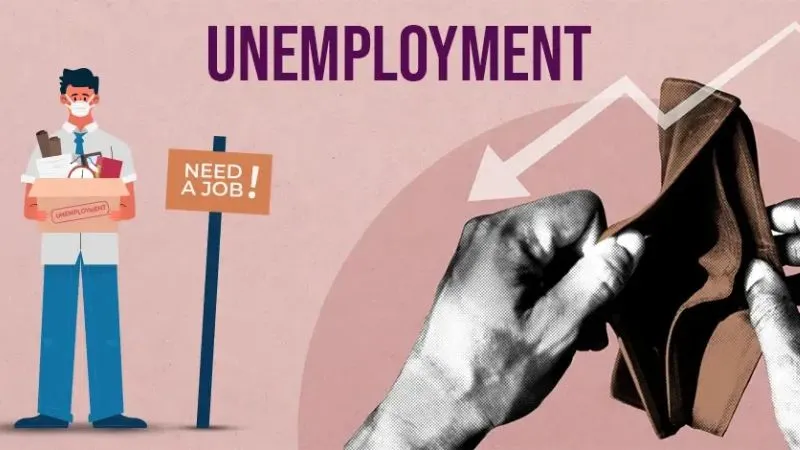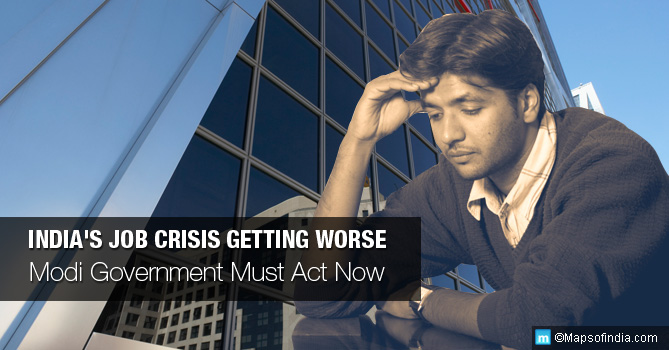Sorry, But There Is ‘NO’ Jobs Crises In India!

India has no jobs crises, that is what our government would like us to believe.
According to the 2022 revision of the World Population Prospects, India’s population stood at 1,407,563,842, with more than 50% of its population below the age of 25 and more than 65% below the age of 35.
In a viral video from Bharuch, Gujarat, hundreds of young aspirants can be seen jostling in a queue to get inside the interview venue for just four vacancies in a chemical company. Then came similar scenes from Mumbai.
The viral video is emblematic of a larger problem. Despite creating millions of jobs, India is still struggling to create enough employment opportunities for its young.
According to a recent Citigroup report, New Delhi will struggle to create sufficient employment opportunities and address the unemployment problem in India, even with a 7 per cent growth rate.
However, India’s labour ministry was quick to refute Citi Group’s conclusion, citing the India Employment Report 2024, which indicates that the rate of job creation in India in the last 10 years has been faster than the prior decade.

Do Statistics Lie?
India’s economic growth in the first three quarters of 2023-24 exceeded 8%, surpassing even the most optimistic projections.
However, a Lokniti-CSDS survey of Delhi’s youth suggests that these figures don’t capture the full picture—80% of respondents reported that finding a job in the last two years has been difficult or very difficult.
The Window Getting Smaller
Let’s start with the broader context. Approximately 63% of India’s population is of working age, a demographic advantage that can potentially transform the economy.
East Asian tiger economies utilized such demographic windows to create significant demographic dividends; however, missing this opportunity could lead to stagnation for India.
India has faced challenges in job creation over the past decade, with the worker-to-population ratio declining from 38.6% in 2011-12 to 37.3% in 2022-23, according to government labour force surveys.
The government has also struggled to create jobs for unskilled and poor workers.
According to the UN University World Institute for Development Economics Research, only 20% of Indians work in manufacturing or IT services, while over 40% remain in agriculture.
Moreover, Indian economist Jayati Ghosh highlights that the benefits of India’s economic growth have been unevenly distributed among the top 10-20% of income earners.

The Youth Unemployment Crisis
The unemployment crisis is most acutely felt by the 8 million young and educated Indians entering the workforce annually; this challenges the long-held belief that education guarantees a job.
A recent report from the International Labor Organization (ILO) found that 83% of India’s unemployed population is young, and 66% are both young and educated.
Interestingly, those without university degrees or even full schooling had a higher employment rate; the ILO describes these findings as “paradoxical improvements” in India’s labour participation rate, workforce participation rate, and unemployment rate.
Despite these figures, the unique situation of India’s labour workforce is not fully captured as the government has yet to release consumption figures from the consumer expenditure surveys, which are typically conducted every five years.
“In the Indian case, a huge percentage of the workforce is in the informal sector, meaning that many are working without a contract, lack social security or insurance, or are self-employed,” says economist Ajit Ranade.
Post-Covid Scenario
The economy rebounded sharply post-Covid, and unemployment fell.
However, this is only part of the story – two negative trends emerged in the job market: many people moved back to agriculture, which often means limited earnings, and many of the new jobs were in the unstable category of self-employment, especially for women.
These challenges were highlighted again in a jobs report released this week by the ILO and the Institute for Human Development based on GOI data.
No Market for the Young
India’s youth employment profile suggests a crisis.
The share of youth who are not in employment, education, or training averaged 29.2% between 2010 and 2019, the highest in South Asia.
A high proportion of educated youth is unemployed, even as industries complain of a shortage of skilled labour.
Apart from a few elite institutions, education in India does not guarantee employability. For example, about 3,700 Ph.D. holders recently applied for the post of a peon in the UP police, where the eligibility criterion was Class V.
Women Not Wanted
The job market seems to send a clear message to women: they are not wanted. In 2019, 53.2% of the female workforce was self-employed; by 2022, this proportion increased to 62%. Many of these women are not even paid.

Stagnant Earnings
Over the past decade, the average monthly inflation-adjusted earnings of regularly salaried and self-employed persons have either declined or remained stable. This is supported by weak consumption data, despite the 8%+ GDP growth figures.
Indian Voters and Job Creation
As India’s marathon election began, unemployment was a significant concern for millions of voters, despite the country’s rapid economic growth.
Since Prime Minister Narendra Modi came to power in 2014, economists have touted India as a powerful rival to China, particularly in global manufacturing, investment, and growth capabilities.
Investors have reason to be optimistic: between 2014 and 2023, India’s GDP grew by 55%, overtaking countries like the UK, France, Italy, and Brazil to become the world’s fifth-largest economy.
The IMF projects that it will likely expand by 6.3% this year—an impressive feat for a trillion-dollar economy.
According to Indian economist Ajit Ranade, the economy has gained momentum from several long-term factors, primarily demography.
“Number one is, of course, the demography,” he says. With an average age of 29 years, India has one of the youngest populations globally, which means “there’s a large, youthful labor force that’s expanding and a virtuous cycle of people who are going to be looking for jobs, earning, spending, consuming, investing, saving, paying taxes, and so on,” says Ranade.
However, a pre-poll survey by CSDS-Lokniti, a Delhi-based research institute, found that nearly half the electorate saw unemployment and rising prices as the two biggest concerns in this election, indicating that India has not yet fully benefited from this demographic advantage.
Consequently, economists suggest that Modi’s government must find new ways to leverage its demographic dividend.
Why Investment in India is Sluggish
In the past, East Asian economies like Korea, Malaysia, and China reached similar development stages through export-led growth in textiles, garments, or electronic assembly.
However, an expanding labor force alone has not led most Indian workers to find productive, higher-paying, and higher-quality jobs.
“We have not seen the same kind of phenomenon because India did not aggressively embrace labor-intensive exports as a big driver of growth,” says Ranade.
The history behind this includes protectionist economic policies implemented after gaining independence from British rule, driven by suspicion of international trade and colonial exploitation.
This included self-reliance in the capital goods sector and heavy investment in Indian railways, steel companies, and nuclear power—an “import substitution-led model,” as Ranade puts it.
Later, between 1988 and 1991, India began embracing economic liberalization policies, pushing industrial growth to 9.2%.
However, since then, excessive regulation around large-scale industry and relatively cheaper capital compared to labor have slowed progress.
According to Barclays research, investment exceeded 40% in 2008 but currently stands at 34%. “The ironic thing is that the share of manufacturing in India’s GDP has barely moved an inch since 1991,” says Ranade.

The Bigger Picture
Under the Modi administration, three significant economic disruptions—demonetization, a “somewhat haphazard” implementation of GST, and pandemic-related lockdowns—have further contributed to this slowdown, according to Reetika Khera, a professor of economics at the Indian Institute of Technology in Delhi.
“Each of these has had a devastating impact on different sections of the economy, especially the vulnerable,” she says.
Despite Modi’s ambitious “Make in India” program to ease the burden of doing business in India, the government’s inability to create more jobs has been surprising.
Another production-linked incentive scheme launched in November 2023 aimed to boost domestic manufacturing by offering industrial incentives.
In this year’s federal budget, the government allocated $134 billion for capital spending on infrastructure projects, mirroring China’s strategy for economic expansion more than three decades ago.
However, when the ruling Bharatiya Janata Party unveiled its election manifesto just days before voting began, it made little mention of the economic policies Modi would pursue in a third term.
According to the World Bank, India currently ranks 147th in living standards, despite projections that its economy will become the third-largest in the world by 2027.
“The mere growth in the aggregate income of the whole economy is not good enough because it is not diffused to all sections of society,” says Ranade. Instead, the gains have disproportionately gone to India’s elite, the top 10%.
To compensate for the lack of jobs and per capita income growth, the government has adopted more welfarist policies, spending money on various ventures for nutrition, employment, security, health, and even subsidized cooking gas for poorer households.
Skill Deficit and Gender Disparities Hinder Youth Employment
Despite India’s youthful demographic, a significant skills gap hampers the workforce’s employability.
The report highlights that many young people lack basic digital literacy skills:
- 90% of Indian youth cannot input a mathematical formula into a spreadsheet.
- 60% cannot copy and paste files.
- At least 75% cannot send emails with attachments.
The report also underlines the widening gender gap in the labor market, with low female labor force participation rates. Young women, especially those with higher education, face substantial challenges in securing employment.

Creating Jobs for an Educated Youth
To provide jobs for its increasingly educated young population, India needs even faster labour-intensive economic growth. Such growth would generate demand across all sections of society, not just the middle class and above.
Between 2004 and 2014, India’s economy grew at nearly 8% per year, even weathering the global financial crisis in 2008.
This rapid growth accelerated structural changes in employment, creating an average of 7.5 million new non-farm jobs annually. The number of manufacturing jobs rose from 53 million in 2004 to 60 million by 2012.
However, the demonetization in 2016, which removed ₹500 and ₹1,000 notes from circulation, intended to push the economy towards formalization, led to acute cash shortages.
This move destroyed jobs in the construction and manufacturing sectors.
Growth slowed further in 2020 when the Covid pandemic prompted a nationwide lockdown with just four hours’ notice, causing India’s GDP to contract by 5.8%, more than double the global economy’s contraction rate.
Employment in manufacturing fell again, particularly in labor-intensive sectors, which had already been declining for five years post-demonetization.
Around 60 million workers returned to agricultural jobs, reversing 15 years of structural employment change.
Leveraging the Demographic Dividend
India needs to create more non-farm jobs to capitalise on its growing working-age population.
In his book “Breaking the Mould,” former Reserve Bank of India Governor Raghuram Rajan argues that India should focus on exporting services, leveraging its new digital infrastructure and IT-based services growth for both domestic and export markets.
Beyond Services
Focusing on services alone will not suffice.
The “New India” economy currently makes up less than 15% of the country’s GDP and even less in terms of employment.
Such a strategy would primarily generate jobs for highly skilled individuals, leaving millions of Indian workers still searching for non-farm jobs.
India needs a manufacturing strategy similar to China’s, which has focused on labor-intensive manufacturing. Since the 1950s, China has pursued an industrial policy that has evolved significantly since the 1980s, establishing its dominance in global high-tech manufacturing.

Creating Jobs in India
Meeting the demand for jobs in India will require several factors to come together.
Construction activity needs to continue at its current brisk pace, led by public sector investment for the next year or two, as private investment remains sluggish.
India’s investment-to-GDP ratio is still below 30%, lower than the 31% inherited by the current government when it came to power a decade ago.
Reviving private investment could lead to a potential twofold increase in construction employment, as seen between 2004 and 201t.
Labor-intensive manufacturing by micro, small, and medium enterprises (MSMEs) also needs sustained support. Currently, the government’s focus is on large companies—so-called “national champions” like Tata and Mahindra—encouraged through subsidies.
Redirecting these subsidies towards smaller enterprises could have a more significant impact on employment generation.
Large corporations typically use highly capital-intensive production methods, whereas smaller enterprises tend to absorb more labor. Historically, smaller enterprises have generated most non-farm jobs in developing countries.
Expanding Employment in Services
The third area for generating employment is the services sector.
Public expenditure should prioritize public health, education, vocational training, and universities. These sectors are labor-intensive, contribute to the creation of public goods, and build the human capital needed for both manufacturing and modern export-oriented services.
This approach is essential for India’s health and education services to reach East Asian levels and attract more foreign investment.
The Last Bit, A renewed focus on smaller enterprises across these sectors is needed.
Inclusive growth requires providing jobs rapidly at the bottom of the pyramid, not only at the top of the wage – and skill – distribution.
Figures suggest that India is one of the fastest-growing economies in the world.
Between July and September of 2023, it grew at a pace of 7.6%. If it continues along this current growth trajectory, India will become the world’s third-largest economy by 2027.
The jobs crisis should be the priority of all political parties, but so far, we haven’t heard of an effective strategy.
Time’s running out!




